What is Digital Sustainability?
In today's rapidly evolving digital landscape, a pressing concern emerges: How can we harness the power of technology while safeguarding the planet and ensuring equitable access for all? Enter the concept of "Digital Sustainability." It's a visionary approach that seeks to strike a harmonious balance between our ever-expanding digital footprint and the imperative to protect our environment and promote social responsibility.
In this blog, we delve deep into the essence of Digital Sustainability, exploring its core principles, real-world business examples, and implementation strategies. From energy-efficient data centres to ethical AI development and circular economy practices, we'll uncover how organisations reimagine their digital practices to align with a greener, more sustainable future.
Join us on this journey to discover how Digital Sustainability reshapes how we interact with technology.
What is Digital Sustainability?
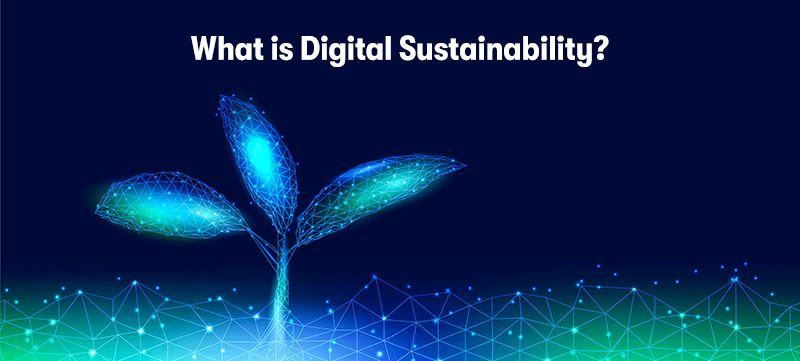
Digital sustainability refers to the responsible and environmentally conscious use of digital technologies and resources to minimise their negative impact on the environment and promote long-term sustainability. It encompasses various aspects of designing, producing, using, and disposing of digital technologies and services to ensure they contribute to a more sustainable future. Here are some key elements of digital sustainability:
Energy Efficiency
Digital sustainability emphasises the need for energy-efficient hardware and software design. This includes reducing the energy consumption of data centres, servers, and electronic devices and optimising software code to run efficiently.
Green Data Centres
Building and operating data centres with a focus on sustainability, such as using renewable energy sources, improving cooling systems, and adopting energy-efficient hardware, is a critical component of digital sustainability.
E-Waste Reduction
Managing electronic waste (e-waste) is a significant concern. Digital sustainability encourages the reuse, recycling, and responsible disposal of electronic devices to minimise environmental impact.
Circular Economy
Digital sustainability supports the transition to a circular economy for electronic products, where devices and components are designed for longevity, repairability, and upgradability rather than being discarded after a short lifespan.
Sustainable Supply Chain
Ensuring that the entire supply chain for digital technologies, from raw materials extraction to manufacturing and distribution, follows sustainable practices is vital for digital sustainability.
Green Software Development
Developing software with a focus on resource efficiency, minimal energy consumption, and reduced carbon footprint is another key aspect of digital sustainability.
Cloud Computing
Optimising cloud infrastructure to reduce energy usage and emissions is crucial, given the increasing reliance on cloud services for digital applications and data storage.
Digital Education and Awareness
Promoting digital literacy and awareness about the environmental impact of digital technologies can help individuals and organisations make more sustainable choices in their digital practices.
Smart Cities and IoT
Integrating Internet of Things (IoT) devices and smart technologies into urban planning and infrastructure in ways that enhance sustainability and reduce resource consumption is a key application of digital sustainability.
Data Privacy and Security
Ensuring the privacy and security of digital data is essential for sustainability, as data breaches can have environmental and social consequences.
Policy and Regulation
Governments and organisations can enact policies and regulations that incentivise or mandate sustainable practices in the digital realm.
Digital sustainability recognises that while digital technologies can provide many benefits, they also have environmental and social costs. By adopting responsible and sustainable practices in developing, deploying, and using digital technologies, we can mitigate these negative impacts and work toward a more sustainable and equitable digital future.
Why is Digital Sustainability Important for Businesses?
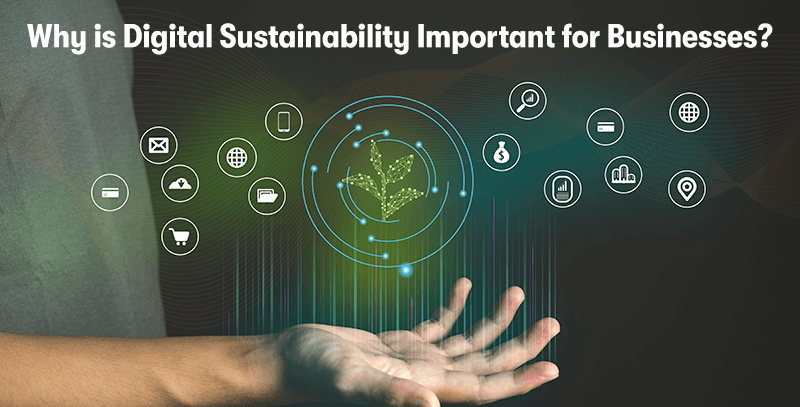
Digital sustainability is not just an ethical or environmental consideration but a strategic imperative for businesses in today's global marketplace. By integrating sustainable practices into their operations, companies can reduce costs, mitigate risks, enhance their competitive position, and contribute to a more environmentally responsible and socially conscious world. Let's explore why digital sustainability is important for businesses in more depth:
Environmental Responsibility
Businesses have a responsibility to minimise their environmental footprint. Digital sustainability initiatives can reduce energy consumption, greenhouse gas emissions, and electronic waste generation, helping companies contribute to global efforts to combat climate change and reduce resource depletion.
Cost Savings
Implementing energy-efficient technologies and practices can lead to significant cost savings. Lower energy consumption, reduced waste, and improved resource management can result in lower operational expenses and increased profitability.
Competitive Advantage
Consumers and investors increasingly prioritise environmentally responsible companies. Businesses that demonstrate a commitment to digital sustainability can gain a competitive edge by attracting environmentally conscious customers, partners, and investors.
Regulatory Compliance
Governments worldwide are introducing regulations and standards related to environmental sustainability, including those that pertain to digital technologies. Adhering to these regulations not only avoids potential fines but also ensures long-term business viability.
Risk Mitigation
Failing to address digital sustainability issues can lead to reputational damage, legal liabilities, and supply chain disruptions. By proactively addressing these issues, businesses can mitigate these risks and maintain their reputation.
Innovation Opportunities
Embracing digital sustainability can drive innovation. Businesses that invest in sustainable technologies and practices discover new opportunities for product development, process optimisation, and market expansion.
Resource Efficiency
Digital sustainability encourages resource-efficient practices, such as the circular economy model. This can lead to optimised resource use, reduced waste, and greater resilience in the face of resource scarcity.
Employee Engagement
Employees often feel motivated and proud to work for organisations prioritising sustainability. Digital sustainability initiatives can enhance employee satisfaction and retention, fostering a positive workplace culture.
Long-Term Viability
Sustainability is a critical factor in long-term business viability. Companies that proactively address environmental and social issues are more likely to thrive in an increasingly competitive and resource-constrained world.
Supply Chain Resilience
Companies that assess and improve the sustainability of their supply chains are better prepared to adapt to disruptions, such as those caused by climate change, resource shortages, or geopolitical factors.
Reputation and Brand Building
Businesses prioritising digital sustainability can build a positive brand image and reputation, leading to increased customer loyalty and trust.
Adaptation to Market Trends
Consumer preferences and market trends are shifting towards sustainability. Companies that align their products and services with these trends are better positioned to meet evolving customer demands.
Digital Sustainability Examples
Here are some examples of digital sustainability initiatives and practices across various sectors and industries:
Data Centre Efficiency
- Implementing advanced cooling techniques, like liquid cooling, to improve energy efficiency in data centres.
- Utilising artificial intelligence (AI) to optimise server workload allocation and reduce energy consumption.
Green Cloud Computing
- Cloud service providers invest in renewable energy sources for powering their data centres.
- Offering cloud services with flexible and energy-efficient scaling to match workload demands.
E-Waste Reduction
- Encourage customers to return or recycle old electronic devices and provide incentives for responsible disposal.
- Designing electronic products with modular and upgradable components to extend their lifespan.
Circular Economy in Electronics
- Electronics manufacturers are facilitating product repair and refurbishment programs.
- Promoting the reuse of components and materials from old electronic devices in new products.
Sustainable Software Development
- Developing software applications that are optimised for energy efficiency and minimal resource usage.
- Emphasising code review and refactoring to eliminate unnecessary code and reduce energy consumption.
Smart Cities and IoT
- Deploying IoT sensors to monitor and optimise energy usage, traffic flow, and waste management in urban areas.
- Using smart grid technologies to improve the distribution and management of electrical energy.
Digital Education and Awareness
- Conducting digital sustainability awareness campaigns to educate employees and customers about responsible digital practices.
- Offering training programs on sustainable IT practices and green computing.
Remote Work and Telecommuting
- Encouraging remote work to reduce the carbon footprint associated with daily commuting.
- Providing virtual meeting and collaboration tools to minimise the need for physical travel.
Sustainable Supply Chain Management
- Tracking and auditing suppliers' environmental and social practices to ensure sustainability throughout the supply chain.
- Incorporating sustainable sourcing principles when selecting materials and components.
Sustainable Data Centres
- Designing data centres with energy-efficient architecture and equipment.
- Installing renewable energy sources like solar panels and wind turbines to power data centres.
Renewable Energy Procurement
- Procuring renewable energy certificates (RECs) or entering into power purchase agreements (PPAs) to source electricity from renewable sources.
- Investing in on-site renewable energy generation, such as solar or wind power, to meet energy needs.
Digitalisation of Paper Processes
- Replacing paper-based processes with digital alternatives to reduce paper consumption and streamline operations.
- Implementing electronic document management systems to minimise printing and paper storage.
These examples demonstrate the diverse ways digital sustainability can be applied across industries and sectors to reduce environmental impact, improve efficiency, and promote responsible digital practices. Organisations can choose initiatives that align with their goals and priorities to contribute to a more sustainable future.
Here are some examples of some organisation's digital sustainability initiatives:
Google Example
Google has been a leader in the tech industry in its commitment to renewable energy. The company announced that it has matched all of its energy consumption with 100% renewable energy sources, including wind and solar power. This initiative is aimed at reducing Google's carbon footprint and promoting sustainability.
Apple Example
Apple has made strides in creating a closed-loop supply chain for its products. The company recovers and reuses materials from old iPhones to manufacture new ones. By doing so, Apple reduces its reliance on mining and lowers the environmental impact of its products.
Microsoft Example
Microsoft is heavily investing in sustainable data centres. For example, they have submerged data centres in the ocean to use cold water for cooling, reducing energy consumption. Microsoft also pledges to be carbon negative by 2030, meaning they will remove more carbon from the environment than they emit.
Salesforce Example
Salesforce follows a 1-1-1 model, where they donate 1% of their equity, 1% of their product, and 1% of their employees' time to charitable causes. This model not only promotes corporate social responsibility but also supports sustainability initiatives.
Looking for a Digital Sustainability Course?
At Purple Griffon, we offer an ITIL® 4 Specialist Sustainability in Digital & IT (SDIT) training course. This course will help you to:
- Understand how to use the ITIL guiding principles to deliver value by creating sustainable digitally enabled products and services.
- Effectively address VUCA challenges through sustainable strategies, procurement, products and practices.
- Obtain a practical grounding in the key principles of sustainability.
- Conduct a complete cost-benefit analysis identifying potential risks and opportunities using best practice guidance.
What are the Principles of Digital Sustainability?
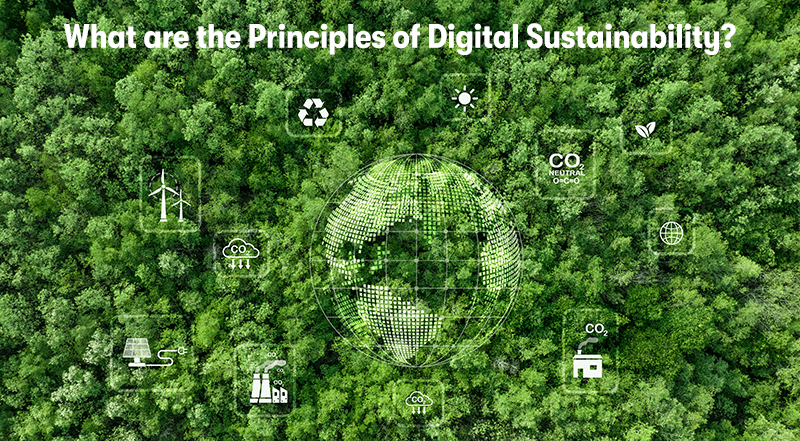
Digital sustainability is guided by several key principles that help organisations and individuals make responsible and environmentally conscious choices in the digital realm. These principles emphasise reducing the environmental impact, promoting resource efficiency, and ensuring ethical and equitable use of digital technologies. Here are the principles of digital sustainability:
Energy Efficiency
Prioritise energy-efficient technologies and practices in digital operations, including data centres, servers, and electronic devices. Minimise energy consumption by optimising hardware and software.
Renewable Energy
Transition to renewable energy sources, such as solar and wind power, to power digital infrastructure and reduce reliance on fossil fuels.
Resource Efficiency
Promote the efficient use of digital resources, including hardware, software, and data storage, to reduce waste and minimise environmental impact.
E-Waste Reduction
Encourage the reuse, recycling, and responsible disposal of electronic devices and components to reduce electronic waste (e-waste) and its harmful environmental effects.
Circular Economy
Adopt a circular economy approach in designing and producing digital products and services. Design devices and components for longevity, repairability, and upgradability to extend their lifecycle.
Sustainable Supply Chain
Ensure that the entire digital supply chain, from raw materials extraction to manufacturing and distribution, follows sustainable practices, including responsible sourcing and ethical labour standards.
Green Software Development
Develop software with a focus on energy efficiency, minimal resource usage, and reduced carbon footprint. Prioritise efficient code and optimise software for low-energy consumption.
Data Privacy and Security
Protect the privacy and security of digital data to ensure ethical and responsible use of technology while safeguarding individuals' rights and personal information.
Digital Inclusion
Promote digital inclusion by ensuring that access to digital technologies and services is equitable and available to all, regardless of geographic location, socioeconomic status, or other factors.
Digital Education and Awareness
Educate individuals and organisations about the environmental impact of digital technologies and promote responsible digital practices through training and awareness campaigns.
Ethical AI and Automation
Develop and use artificial intelligence and automation technologies with ethical considerations, ensuring fairness, transparency, and accountability in decision-making processes.
Regulatory Compliance
Comply with local and international regulations related to digital sustainability, environmental responsibility, and data privacy to avoid legal and regulatory risks.
Transparency and Reporting
Provide transparency regarding digital sustainability efforts and outcomes through reporting and disclosure mechanisms to build trust with stakeholders.
Collaboration
Collaborate with other organisations, governments, and civil society to share best practices, innovations, and knowledge related to digital sustainability.
Continuous Improvement
Commit to ongoing improvement in digital sustainability practices by regularly assessing and optimising operations, technologies, and policies.
These principles of digital sustainability serve as a framework for organisations and individuals to make informed choices and take responsible actions in the digital domain, with the overarching goal of reducing the negative environmental and social impacts of digital technologies while promoting long-term sustainability.
What are the Main Focus Areas for Digital Sustainability?
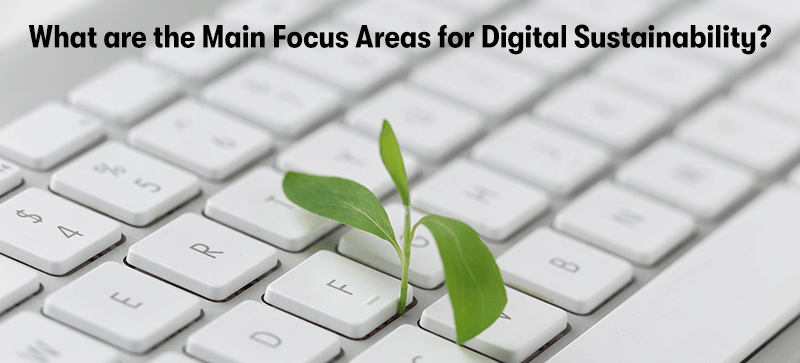
Digital sustainability encompasses a wide range of focus areas aimed at reducing digital technologies' environmental and social impact and ensuring their responsible and sustainable use. The main focus areas for digital sustainability include:
Energy Efficiency
Minimising the energy consumption of digital infrastructure, including data centres, servers, and electronic devices, through efficient hardware design and optimised software.
Renewable Energy
Transitioning to renewable energy sources, such as solar and wind power, to power digital operations and reduce reliance on fossil fuels.
E-Waste Reduction
Encouraging the reuse, recycling, and responsible disposal of electronic devices and components to reduce electronic waste (e-waste) and its environmental consequences.
Circular Economy
Designing digital products and services focusing on longevity, repairability, and upgradability to extend their lifecycle and reduce waste.
Sustainable Supply Chain
Ensuring the entire digital supply chain, from raw materials extraction to manufacturing and distribution, follows sustainable practices, including responsible sourcing and ethical labour standards.
Green Software Development
Developing software with energy efficiency in mind, optimising code, and reducing resource consumption to minimise the carbon footprint of digital applications.
Data Privacy and Security
Protecting the privacy and security of digital data to ensure ethical and responsible use of technology while safeguarding individuals' rights and personal information.
Digital Inclusion
Ensuring equitable access to digital technologies and services for all individuals, regardless of geographic location, socioeconomic status, or other factors.
Digital Education and Awareness
Promoting awareness and responsible digital practices through education and training on the environmental impact of digital technologies.
Ethical AI and Automation
Developing and using artificial intelligence and automation technologies with ethical considerations, ensuring fairness, transparency, and accountability in decision-making processes.
Regulatory Compliance
Complying with relevant local and international regulations related to digital sustainability, environmental responsibility, and data privacy to avoid legal and regulatory risks.
Transparency and Reporting
Providing transparency regarding digital sustainability efforts and outcomes through reporting and disclosure mechanisms to build trust with stakeholders.
Collaboration
Collaborating with other organisations, governments, and civil society to share best practices, innovations, and knowledge related to digital sustainability.
Continuous Improvement
Committing to ongoing improvement in digital sustainability practices by regularly assessing and optimising operations, technologies, and policies.
Smart Cities and IoT
Integrating Internet of Things (IoT) devices and smart technologies into urban planning and infrastructure to enhance city sustainability and resource efficiency.
Remote Work and Telecommuting
Promoting remote work and telecommuting to reduce carbon emissions associated with daily commuting and encourage flexible work arrangements.
Responsible Consumption
Encouraging responsible consumption of digital goods and services, including minimising unnecessary digital purchases and promoting long-term usage of electronic devices.
These focus areas collectively address the various aspects of digital sustainability, from energy efficiency and waste reduction to ethical considerations and inclusive access, with the goal of mitigating the negative impacts of digital technologies and advancing sustainability in the digital realm. Organisations and individuals can choose specific areas of focus based on their priorities and objectives.
How is Digital Sustainability Implemented Within Businesses?
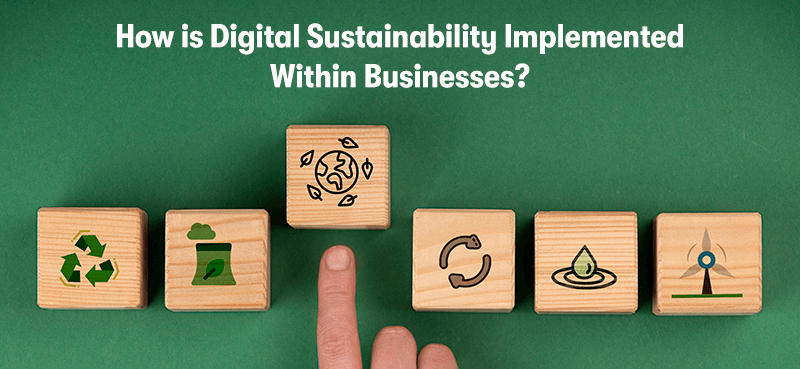
Implementing digital sustainability within businesses involves a systematic and holistic approach that integrates sustainable practices into various aspects of the organisation's operations and culture. Here's how digital sustainability can be implemented within businesses:
Assessment and Planning
- Start with a thorough assessment of the organisation's digital operations and environmental and social impacts.
- Identify key areas where sustainability improvements can be made.
- Develop a digital sustainability strategy that outlines specific goals, targets, and timelines.
Leadership and Commitment
- Secure commitment and support from top-level leadership within the organisation.
- Appoint a sustainability champion or team responsible for driving digital sustainability initiatives.
Energy Efficiency
- Invest in energy-efficient hardware and data centre technologies.
- Implement energy-saving practices such as server virtualisation and dynamic power management.
- Regularly monitor and optimise energy consumption in data centres and IT infrastructure.
Renewable Energy Adoption
- Transition to renewable energy sources for powering data centres and offices.
- Consider entering into power purchase agreements (PPAs) or purchasing renewable energy certificates (RECs).
E-Waste Management
- Establish e-waste recycling and disposal programs.
- Encourage employees and customers to return old electronic devices for recycling.
- Partner with responsible e-waste recycling firms.
Circular Economy Practices
- Design electronic products and devices focusing on durability, repairability, and upgradability.
- Explore options for reusing components from old devices in new product manufacturing.
Supply Chain Sustainability
- Collaborate with suppliers to ensure responsible sourcing of materials and adherence to ethical labour practices.
- Evaluate and select suppliers based on their environmental and social performance.
Green Software Development
- Train software developers in energy-efficient coding practices.
- Implement code review and optimisation processes to reduce resource consumption.
- Consider the use of energy-efficient programming languages and frameworks.
Data Privacy and Security
- Implement robust data protection and cybersecurity measures to safeguard digital assets and user information.
- Comply with data privacy regulations and standards.
Digital Inclusion
- Promote digital inclusion by offering accessibility features in digital products and services.
- Consider affordability and access for underserved communities when designing digital solutions.
Digital Education and Awareness
- Educate employees about digital sustainability principles and practices.
- Raise awareness among customers and partners through marketing and communication campaigns.
Ethical AI and Automation
- Implement ethical guidelines for the development and deployment of AI and automation technologies.
- Ensure fairness, transparency, and accountability in algorithmic decision-making.
Regulatory Compliance
- Stay informed about relevant regulations related to digital sustainability and ensure compliance.
- Participate in industry associations and initiatives that promote sustainable practices.
Transparency and Reporting
- Publish regular reports on digital sustainability efforts and achievements.
- Share progress with stakeholders, including customers, investors, and employees.
Collaboration
- Collaborate with industry peers, government agencies, and NGOs on sustainability initiatives and knowledge sharing.
- Participate in sustainability-focused partnerships and alliances.
Continuous Improvement
- Continuously assess and refine digital sustainability initiatives based on performance data and changing circumstances.
- Set new sustainability targets and goals as the organisation evolves.
Employee Engagement
- Engage employees in sustainability efforts through training, incentives, and recognition programs.
- Foster a culture of sustainability and responsibility within the organisation.
External Certification
- Consider seeking certifications, such as ISO 14001 (environmental management) or B Corp certification, to validate and showcase sustainability efforts.
Customer and Stakeholder Engagement
- Involve customers and stakeholders in sustainability discussions and seek their input on sustainability initiatives.
- Listen to feedback and make adjustments based on their expectations and preferences.
Implementing digital sustainability is an ongoing process that requires dedication, collaboration, and adaptability. By integrating these practices into their operations and culture, businesses can reduce their environmental impact, improve efficiency, and contribute to a more sustainable future.
Final Notes on Digital Sustainability
In the quest for a more sustainable future, the principles of digital sustainability have emerged as a guiding light for businesses worldwide. These principles advocate for energy efficiency, renewable energy adoption, responsible e-waste management, and the transition to a circular economy in electronics. Organisations can reduce their environmental and social footprint by fostering supply chain sustainability, green software development, and ethical AI.
Moreover, digital inclusion, education, and data privacy remain crucial pillars. Implementing digital sustainability requires leadership commitment, employee engagement, and transparency in reporting progress. As businesses collaborate, continuously improve, and engage with customers and stakeholders, they reduce their impact on the planet and embrace a more responsible and ethical approach to digital technology. In doing so, they move closer to a brighter, more sustainable digital future.


